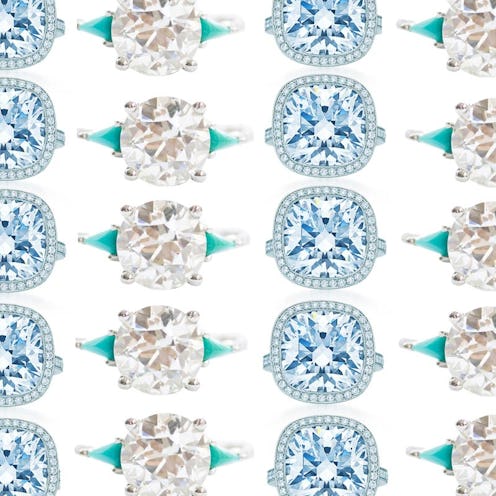A diamond engagement ring is usually the most expensive item in a woman’s jewelry box. Because diamonds are such an investment, most modern couples discuss ring styles ahead of the actual proposal to avoid having an awkward, does-he-even-know-me moment. If you are on the cusp of getting engaged, make sure you really know what you want. To help, we enlisted Jerry Ehrenwald, the President and CEO of the International Gemological Institute. Using his expertise, along with rings from our favorite jewelry designers, we dive deep into the 4 Cs: cut, carat, clarity and color. By the time we’re done, you’ll be 100-percent positive which ring style best suits you. (Don’t worry, we too met our spirit diamond before our soul mate.)
Your Guide To Buying Diamonds
Bling 101.
Cut refers to the shape of a diamond and describes the design of the facets. According to our expert, cut is a major factor in cost. "Round brilliant diamonds have 58 facets and are generally the most expensive because of high demand," he says, "and because more rough stone is lost when cutting a round diamond."
Bigger is not always better. Prices vary dramatically for diamonds of the same carat weight based on clarity and color. "It depends how you define perfect. For example, according to the Rapaport Diamond Report, a round brilliant cut, D color (totally colorless), internally flawless (IF), 1 carat diamond is approximately $24,200," says Ehrenwald. "As a second example, according to the same report, a round brilliant cut, F color (still top range of colorlessness), VVS2 clarity (very very slightly included), 1 carat diamond is approximately $10,700."
Clarity addresses the stone's imperfections, otherwise known as inclusions. The rating system goes from IF (internally flawless) to VVS1-VVS2 (very, very slightly included), scaling all the way down to P1-P3, which is the rating for a flawed, imperfect diamond. "A slightly included diamond is typically much less expensive than an internally flawless diamond," says Ehrenwald. "Theoretically, in a SI1 (slightly included 1) clarity diamond the inclusions cannot be detected by the naked eye, however with a SI2 clarity (slightly included 2) inclusions can be seen."
While a white diamond is the most common, colored stones (referred to as "fancy"—yes, that's a technical term) can actually be even more luxe. "Colorlessness is represented on a D-Z scale, with D being the most colorless diamond," says Ehrenwald. "Among fancy-colored diamonds, the rarest colors—in order—are vivid blues, pinks and yellows. Given the high price and rarity of fancy-colored diamonds, yellows are by far the most popular among consumers, followed by pink."
